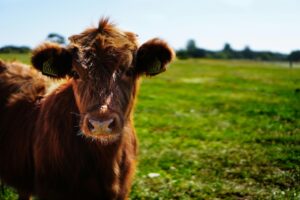In recent years, there’s been a surge in articles claiming that reducing beef consumption is crucial for combating climate change and promoting health, often promoting plant-based diets as the superior alternative. These articles are daftly misleading, oversimplifying complex issues like environmental sustainability, the nutritional value of meat, and the potential health implications of plant-based proteins like soy.
The Carbon Cycle and Pastured Beef
The claim that beef production is a primary driver of climate change often focuses on feedlot operations that are indeed resource-intensive and have significant emissions. However, this narrative neglects the carbon sequestration potential of pastured beef operations and regenerative agriculture practices. When managed using regenerative practices like rotational grazing, cattle can contribute positively to the environment.
Rotational grazing involves systematically moving livestock to different pasture areas, allowing vegetation in previously grazed areas to recover. This process mimics natural grazing patterns of wild herbivores, promoting biodiversity and encouraging the growth of deep-rooted grasses. These grasses play a crucial role in sequestering carbon from the atmosphere and storing it in the soil. The roots help capture carbon dioxide from the atmosphere and store it in the soil as organic carbon. A study by Teague et al. (2016)1 found that well-managed grazing systems could sequester enough carbon to offset not only their own emissions but also additional carbon, making them carbon-negative.
Soil Health and Biodiversity
Beyond carbon sequestration, pastured beef operations contribute to overall soil health. The presence of grazing animals enhances the soil’s organic matter content, increases water retention, and supports a diverse ecosystem of microorganisms. This biodiversity further boosts the soil’s ability to store carbon and maintain fertility. Unlike monocrop agriculture, which can deplete the soil over time, properly managed grazing can rejuvenate the land, promoting long-term sustainability.
Healthy soils enriched with organic matter from decomposing plant material and animal manure have increased microbial activity, which contributes to soil structure and fertility. This enhanced soil structure improves water infiltration and retention, reducing runoff and erosion. In areas prone to drought, these improved water retention capabilities can be critical for maintaining ecosystem resilience.
Contrast with Industrial Agriculture
In contrast, conventional agriculture, particularly the cultivation of soy and other plant-based proteins, often involves practices like tilling and the use of synthetic fertilizers and pesticides. These practices can degrade soil health over time, leading to a loss of soil organic matter and decreased capacity for carbon sequestration. Furthermore, industrial monocrop farming can lead to habitat loss and a decline in biodiversity, whereas well-managed grazing systems can enhance biodiversity by creating varied habitats and promoting plant diversity.
Labeling all beef production as environmentally detrimental oversimplifies the issue and ignores the benefits of regenerative grazing practices, as well as the harms of industrial farming practices.
The Myth of Deforestation and Beef Production
While deforestation for beef production is a legitimate concern in some parts of the world, particularly in the Amazon rainforest, it’s important to distinguish between different types of beef production systems. In the United States and many other countries, much of the beef is produced on existing pasturelands rather than through deforestation. In fact, about two-thirds of U.S. agricultural land is only suitable for grazing due to factors like soil quality and terrain, making it ideal for raising cattle but unsuitable for crop production. Moreover, regenerative grazing practices aim to work with the land to improve its health and productivity without the need for further deforestation.
This approach utilizes marginal lands that would otherwise remain unused, contributing to a more sustainable food system while enhancing soil health and biodiversity.

The Hormonal Impact of Soy on Human Health
There is a growing movement against beef consumption that often promotes soy as a suitable alternative. However, this narrative can be problematic, as it overlooks the potential hormonal impacts of soy on human health. While soy is widely marketed as a healthy, plant-based protein, it contains compounds that can affect hormone levels, especially when consumed in large quantities.
Understanding Phytoestrogens
Soy contains compounds known as phytoestrogens, particularly isoflavones, which are plant-derived molecules with estrogen-like properties. These compounds can bind to estrogen receptors in the human body, potentially influencing hormone balance. This interaction can have varying effects depending on the individual and the amount consumed. While the effects of phytoestrogens are less potent than human estrogen, their presence in the diet, especially in large amounts, can have noticeable physiological impacts.
In men, excessive soy consumption has been associated with decreased testosterone levels and hormonal imbalances. Research in Reproductive Toxicology2 has shown that high intake of soy can impact reproductive health by reducing testosterone levels. While moderate soy consumption is generally considered safe, large quantities can potentially influence hormone levels, especially in individuals who rely heavily on soy-based products as their primary protein source.
Effects on Men
In men, excessive soy consumption has been associated with decreased testosterone levels and hormonal imbalances. Some studies have raised concerns about soy consumption and its potential feminizing effects on men. Excessive intake of soy has been linked to decreased testosterone levels and altered hormone balance in certain cases.
Research in Reproductive Toxicology has shown that high intake of soy can impact reproductive health by reducing testosterone levels. While moderate soy intake is less likely to cause significant hormonal changes, men who consume large amounts of soy-based products, especially in individuals who rely heavily on it as their primary protein source, might experience endocrine disruptions.
Effects on Women
In women, the impact of soy is more complex. Some studies suggest that phytoestrogens can help balance hormones, particularly during menopause, by mimicking estrogen and alleviating symptoms like hot flashes. However, there are also concerns that high levels of soy intake could interfere with normal hormonal function, potentially affecting menstrual cycles or increasing the risk of hormone-sensitive conditions like breast cancer.
Soy and Thyroid Function
Another area of concern is the potential impact of soy on thyroid function. Isoflavones in soy can inhibit the enzyme thyroid peroxidase, which is necessary for the production of thyroid hormones. In individuals with pre-existing thyroid conditions or iodine deficiency, excessive soy intake could exacerbate thyroid dysfunction.

Nutritional Superiority of Meat Over Plant-Based Foods
Bioavailability of Nutrients
One of the key advantages of animal-based foods over plant-based ones is the bioavailability of nutrients. Animal products provide nutrients in forms that are more easily absorbed and utilized by the human body. For example:
Iron: Meat contains heme iron, which is absorbed3 at a much higher rate (15-35%) compared to non-heme iron found in plants (2-20%). This makes meat a more efficient source of iron, crucial for preventing anemia.
For comparison, spinach is one of the highest iron-containing vegetables, offering about 2.7 milligrams of iron per 100 grams. In contrast, beef provides approximately 2.6 milligrams of iron per 100 grams. However, the key difference lies in the type of iron and its bioavailability:
- Heme Iron (Beef): Found in animal products like beef, heme iron is more readily absorbed by the body. This high bioavailability means that even though beef has a similar iron content to spinach, the body can absorb and utilize the iron from beef far more effectively. If you consume 100 grams of beef, you might absorb up to 0.9 to 1.6 mg of iron.
- Non-Heme Iron (Spinach): The iron in spinach is non-heme iron, which has a lower absorption rate. The presence of certain compounds in plants, such as phytates and oxalates, can further inhibit the absorption of non-heme iron, reducing the amount the body can actually use. From 100 grams of spinach, you might only absorb around 0.05 to 0.54 mg of iron, depending on the presence of absorption enhancers or inhibitors.
While spinach and other leafy greens are valuable sources of iron, the body absorbs the iron from beef much more efficiently. The higher bioavailability of heme iron in meat makes it a superior source for meeting the body’s iron needs and preventing deficiencies like anemia, especially for individuals with higher iron requirements.
Protein: Animal proteins are complete proteins, meaning they contain all nine essential amino acids in the right proportions needed by the body. Plant proteins often lack one or more essential amino acids, requiring careful combination of different plant foods to meet dietary needs.
Vitamin B12: This essential vitamin is naturally found only in animal products. It’s crucial for nerve function, brain health, and the production of DNA and red blood cells. Vegans and vegetarians must rely on fortified foods or supplements to obtain adequate B12.
Nutrients Unique to Meat
There are certain nutrients that are either absent or present in negligible amounts in plant foods, including:
Creatine: Found primarily in meat, creatine4 is essential for muscle function and energy production. It’s also linked to improved cognitive function.
Carnosine: An antioxidant that helps reduce inflammation and protect cells from damage. It’s found in significant amounts only in animal products.
Docosahexaenoic Acid (DHA): An omega-3 fatty acid crucial for brain health, primarily found in fatty fish and other seafood. While plant-based sources like flaxseeds provide alpha-linolenic acid (ALA), the body converts ALA to DHA inefficiently.
The Role of Meat in Human Evolution
Anthropological evidence suggests that the consumption of meat played a significant role in human evolution. The dense nutrient profile of meat, particularly in terms of protein and fat, may have supported the development of the human brain and overall health. The high energy and nutrient density of meat made it an efficient food source for early humans, contributing to our evolutionary success.
Let’s Recap
The narrative that reducing or eliminating beef consumption is the best option for health and the environment overlooks the complexities of sustainable agriculture and human nutrition. Pastured beef operations, when managed responsibly, can actually be carbon-negative, contributing to soil health and carbon sequestration. The consumption of soy in large quantities presents potential health concerns due to its phytoestrogen content, with implications for both men and women. Meat, particularly beef, offers a range of nutrients that are more bioavailable than those found in plant sources, and it contains several essential nutrients that are not readily available in a vegan or vegetarian diet.
By taking a holistic view of food production and nutrition, it becomes clear that both plant and animal-based foods have their place in a balanced diet and sustainable food system. The focus should be on responsible, regenerative practices that ensure environmental health, animal welfare, and optimal human nutrition.
Regenerative agriculture is our path forward.
Sources
- Teague, W. R., et al. “The role of ruminants in reducing agriculture’s carbon footprint in North America.” Journal of Soil and Water Conservation 71.2 (2016): 156-164. ↩︎
- Lone Storgaard, Jens Peter Bonde, Jørn Olsen. “Male reproductive disorders in humans and prenatal indicators of estrogen exposure: A review of published epidemiological studies.” Reproductive Toxicology Volume 21, Issue 1 (2006): 4-15, ↩︎
- Iron Bioavailability: Institute of Medicine (US) Panel on Micronutrients. “Dietary Reference Intakes for Vitamin A, Vitamin K, Arsenic, Boron, Chromium, Copper, Iodine, Iron, Manganese, Molybdenum, Nickel, Silicon, Vanadium, and Zinc.” ↩︎
- Carnosine and Creatine: Harris, R. C., et al. “The creatine content of human muscles.” Science in Sports and Exercise 27 (1995): 592-598. ↩︎






